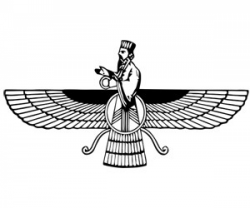Faravahar

This symbol, known as the faravahar (or, alternatively, the farohar), is the central icon of Zoroastrianism, a religion that emerged in ancient Persia (modern-day Iran) some time in the first millennium B.C.E.
The prophet Zarathustra (Zoroaster is the Greek version of his name) was the founder of one of the world’s first codified monotheistic faiths. In his teachings, Ahura Mazda, the supreme deity of light and truth, is in eternal conflict with Ahriman, the ruler of darkness. Fire worship is a primary aspect of Zoroastrianism, and the religion itself is still practiced by people today (one modern group of followers is known as the Parsees and are centered in Mumbai, India).
The central imagery of the faravahar consists of a winged solar disc topped by the figure of a man. The solar disc was a prominent symbol in Egypt and the Middle East long before the birth of Zoroastrianism, and the three layers of feathers on the wings represent the faith’s three primary tenants; good thoughts, good words and good deeds. The human figure on top is a representation of Zoroaster himself, and serves as a reminder to lead an upright and moral life.
© Symbols.com
